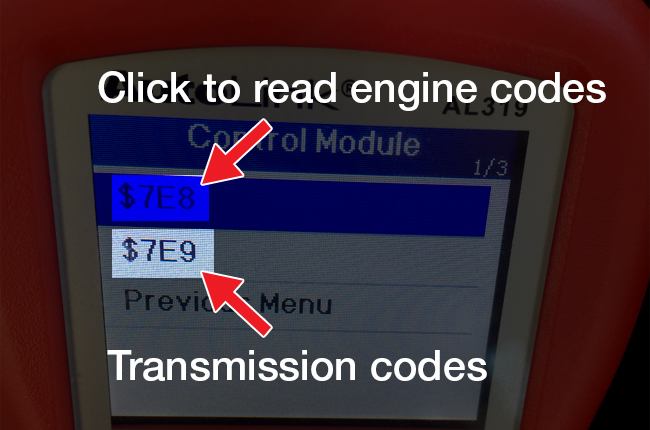Here’s a hypothetical situation for you. Your check engine light is on, and maybe your car has entered limp mode. So you decide to buy a code reader to see what’s really going on with it.
The device gives you the codes $7E8 and $7E9. But what issues do these codes indicate? What needs to be fixed?
These are not actually engine codes. $7E8 and $7E9 are just sub-menus for the engine and transmission control modules.
Let’s dig deeper!
$7E8 & $7E9 engine code – What do they mean?

Again, $7E8 & $7E9 are not engine codes. A basic OBD2 scan tool offers a few different modes (from 1 to 10) to perform particular tasks on your cars. In this case, $7 represents mode 7, which basically means diagnostic code request.
E8 (or E9) indicates that fault codes have been requested from module E8 (or E9). In conclusion:
- $7E8: request codes from the engine module
- $7E9: request codes from the transmission module
What you have to do when seeing these sub-menus is to click on them to drill down further, and you’ll received the actual fault codes.
For both of these modules, you’ll get powertrain codes, which are Pxxxx (e.g., P0218 or P0171).
Most common fault codes in $7E8 & $7E9
The table below show the most common fault codes that you’re most likely to have.
Note: It’s not 100% certain that your car will throw these codes. However, as a mechanic, I would say that there’s roughly a 70% chance that you’re going to have those. Whatever codes you receive, leave a comment below. I’ll try my best to help you all.
| $7E8 | Description | $7E9 | Description |
|---|---|---|---|
| P0171-P0175 | Faulty oxygen sensor | P0218 | Transmission over temperature |
| P0300-P0305 | Engine misfire | P0613 | Transmission control module (TCM) |
| P0411, P0440, P0442, P0446, P0455 | Evaporative system | P0614 | ECM/TCM incompatible |
| P0401 | Faulty EGR valve | P0700 | Transmission control system malfunction |
| P0420, P0430 | Bad catalytic converter | P0706 | Transmission range sensor circuit range/performance |
| P0715 | Input/turbine speed sensor circuit malfunction | ||
| P0720 | Output speed sensor circuit malfunction | ||
| P0729-P0736 | Gear ratio problems |
What do 7EA, 7EB, 7EC, 7ED, 7EE, 7EF mean?
Just like 7E8 and 7E9, these 7Ex sub-menus are not engine codes (and they are not as common as 7E8 and 7E9).
7EA, 7EB, 7EC, 7ED, 7EE, 7EF refer to the communication CAN identifier. Some OBD2 code readers use these codes when they need more information, such as which part of the ECU (engine control unit) needs to be scanned.
- 7EA: Physical response CAN identifier from ECU #3
- 7EB: Physical response CAN identifier from ECU #4
- 7EC: Physical response CAN identifier from ECU #5
- 7ED: Physical response CAN identifier from ECU #6
- 7EE: Physical response CAN identifier from ECU #7
- 7EF: Physical response CAN identifier from ECU #8
When the tool has access to these sub-menus, click on all of them to check if there are any fault codes.
Conclusion
Getting to the $7Ex sub-menus is the very first step towards understanding what’s wrong with your car. It’s important to go through all of the sub-menus you have and drill down as far as you can. At the end of the day, you still want to look for all of the potential issues to turn off that annoying check engine light (or transmission light) off.
once you’ve received the actual code, you’ll know where the actual problem is. The problems may be super easy to fix, or could be very complicated. Whatever comes up, don’t forget to leave a comment below and I’ll do the best I can to help!



$7E8 and $7EA Engine Chevrolet Silverado 2014 Truck
What codes do you have?
I have a 2015 Chevy Traverse that I bought new in 2015. I’ve never had major engine problems with this vehicle before. When I perform a scan I get:
$7E8:
P0171 System Too Lean Bank
P0174 “” 2
P0496 Evaporative Emission System
High Purge Flow
$7EA: No codes
P0496 causes both of the code P0171 and P0174 (lean condition, which means too much air, not enough fuel)
You can try:
– Tighten the fuel cap
– Clean or replace the purge solenoid valve
– Repair or replace the fuel tank pressure sensor
First of all; thank you for being so helpful!!!
I have a 2009 Silverado 1500 – 6 cyl that my reader shows as having diagnostic code P0700 – sub code $07e8, and sub #2 is – $07e8pd.
The diagnostic reader says it’s a transmission code.
After more research I have found that it “could” be a faulty Volume/Mass air flow sensor, which is very easy to replace. That said, it seems like there are a number of things that could be causing the code.
Any advice you could offer me would be greatly appreciated.
Thanks so much,
Stu Neyland
First, I can’t think of any reasons why a faulty maf sensor can cause the code P0700. Usually, it will throw the codes P0101.
Secondly, common causes for P0700 are faulty transmission control module, transmission valve body fault, shift solenoid issues, or open or short in the wiring harness.
Hope it helps
A few times my 2011 volvo V50 D4 has entered slow mode with ‘engine system service required’
This is very sporadic and limp mode deactivates after switch off (service warning goes away after a few starts) car runs smoothly all other times.
I checked for code with a cheap obd2 and P0000 $07e8 pd Manufacturer control appeared.
Previous to all of this a low oil message appeared and i topped up 600ml, last garage full service/oil change was 12000 miles ago.
Any comments much appreciated.
Hi, the code P0000 is quite rare and it means no fault code.
Bad news for you, the limp mode and the CEL can mean that there is something wrong with the communication between the engine and the transmission.
And you are using a cheap scan tool, which can’t read these kinds of fault codes.
Thank you for your reply.
This is a six speed manual gearbox and the code has appeared a couple of times on mild acceleration or sitting at 70mph on a motorway on cruise, and once during hard acceleration.
You are correct about the scan tool, it is a cheap one that i have borrowed.
Would you suggest a trip to Volvo/vida at this time ?
One other thing, i always fill the car to the max and refill on about a gallon left (500/600 miles). The code never appeared on the last fill but almost immediately did it after yesterdays fill. I have read about a filler cap issue, or should i dismiss that ??
Thanks again.
If that’s the cap issue, there should be fault codes indicating a lean condition. But you don’t have them, so I would say that is very likely to be irrelevant.
And yes, a trip to your mechanic is the way to go in this case as I highly doubt that your car has problems with the communication protocol, which is fairly complicated to fix.
Thanks again for your reply.
I havent managed to get it on a proper tester yet, though it has not faulted again in the last 350 miles.
I shall keep you posted when i find out the cause of this.
Thank you!
Saved me some real aggravation and potentially a lot of money! Info was invaluable!
Thank you for sharing your knowledge. My reader had a 7EA code (because of dead battery) and someone else’s blog says 7EA you need to take your car to a mechanic. Good job Tim.
Good day. I have a porsche cayenne throwing a 7EE and a 7E9:A/T code on scanner. Hope you can interpret its status.
Hi Henry. These aren’t unfortunately error codes, but rather sub-menu codes generated by the scanner itself which indicate which vehicle module is giving the error. If you click on these sub-menu codes, you should get the actual error code (starting with a “P” and followed by four numbers “XXXX”, eg: “P0000”) Can you tell me what problem you’re having and what the actual engine codes are so that we can perhaps try assist?
I have a 2011 Kia Sportage with codes $7E8 and $7E9 and the shifter stays in park until I push the shift release lock, It’s running good if I shut the codes off they come right back on. Could anyone help??
Thanks, Kari 🙂
Hi Kari, codes $7E8 and $7E9 aren’t unfortunately error codes, but rather sub-menu codes generated by the scanner itself, which you need to select (or drill down on further) in order to receive the actual error code. Can you tell me what what the actual error codes are so that we can perhaps try assist?
While the error codes may be related to the shifter release issue you’re having, it is a little bit more tricky to tell what the actual problem is. The first thing you should check is the fuse and power source to the interlock solenoid and replace any damaged fuse/s if necessary. You can also check the shift lock release button for loose wiring connections or corroded wiring which will need to be addressed. If these more minor issues aren’t the problem, you may need to approach a mechanic to check it out as the shift lock release button itself may need to be repaired or replaced, or the shift lock release cable may be detached and that’s normally a slightly more complicated fix if you don’t know exactly what you’re doing.